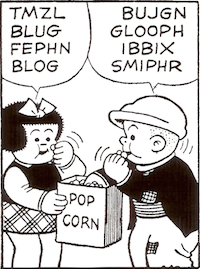Whoso would be a G-Man must be a pencil user, as Emerson might have put it.¹ The pencil is the FBI's writing instrument of choice in The House on 92nd Street (1945, directed by Henry Hathaway), a movie whose interiors seem to have been furnished by a pencil fanatic. Pencils are the tools of counter-espionage in this movie: we see glassfuls in various work areas, and again and again we see the Dixon Ticonderoga, always the Dixon Ticonderoga, in government hands. (The ferrule, with its three dark bands, is the giveaway.)
I have no idea whether The House on 92nd Street is accurate in its depiction of pencil-wielding FBI agents. But the depiction is plausible. Unlike a fountain pen, a pencil is ready to write without priming. It has no cap to unscrew and keep track of. It cannot skip or clog or leak. It remains available for sporadic notetaking without drying out. Its lifespan is always visible: one will never be surprised by unexpectedly running out of ink (or, as with a mechanical pencil, out of lead). If a point breaks, it can be resharpened, or another pencil can substitute. The plainness of the wooden pencil — just doing my unglamorous job, ma'am — seems to fit the G-Man ethos.²
"Well, I guess that's all": a G-Man posing as a Civil Defense worker pockets his Ticonderoga.
Distinguished physicist Dr. Arthur C. Appleton (John McKee) uses a Dixon Ticonderoga to do some calculations concerning Process 97.
Inspector George A. Briggs (Lloyd Nolan) is Inspector Dixon Ticonderoga himself. He never uses his desk sets (yes, he has more than one, as we'll see), just pencils. Note the ferrule of the pencil in his hand.
Dixon Ticonderoga noir! Five more pencils wait on the notepad. Great phone and film projector too.
Two desk sets, two rocking blotters (!), and two pencils, one Dixon Ticonderoga and one anonymous. Inspector Briggs holds a page with some of the details of Process 97, which seems to be the secret process for making a snowman.
¹ From "Self-Reliance": "Whoso would be a man must be a nonconformist."
² The ballpoint pen wasn't for sale in the United States until October 1945, after the movie's release.
Related posts
The dowdy world on film
Film noir pencils
Musical-comedy pencils
Pocket notebook sighting: The House on 92nd Street
Q and A
The real Mr. T (A Dixon Ticonderoga spokespencil)
Young woman with a pencil
And at Pencil Revolution, a photo-essay on some old Castell 9000s: Serious pencils indeed.
Tuesday, April 1, 2008
Is there a pencil in The House?
By
Michael Leddy
at
8:41 AM
![]()
Subscribe to:
Post Comments (Atom)



comments: 7
Great post!
Thanks, Rachel!
I remember (but have no way to back it up) that a pencil was the traditional way to sign off on projects at the FBI as they made their way upward. If you approved and J. Edgar disapproved, you simply erased your approval as the memo made its way back down.
I just found this passage:
Hoover is the only person in the FBI who uses blue ink, so that his messages are instantly recognizable. Other FBI officials use pencil, in part because if they approve a memo moving up the chain of command and then Hoover inks in his disapproval, they can erase their judgment as the memo descends through the chain.
From The File on J. Edgar Hoover (Time, October 25, 1971)
A very enjoyable post!
Pencils also prove to be quite good in cold weather, when most pens stop working due to their internal mechanisms freezing up.
Wonderful!
Are Dixon Ticonderogas still used/made?
Stephen, good observation (I almost said point).
CW, here's the company website: Dixon Ticonderoga.
Post a Comment